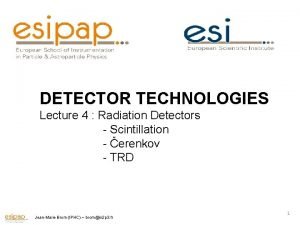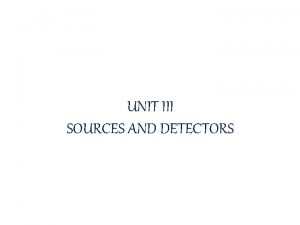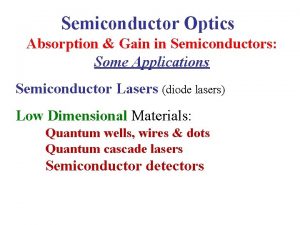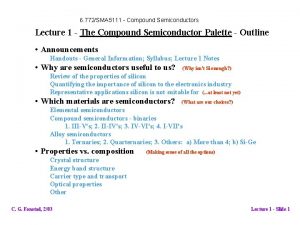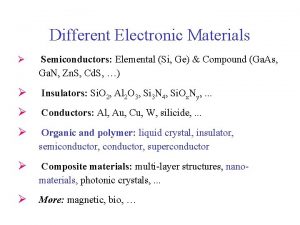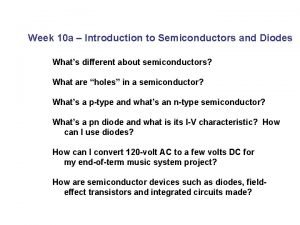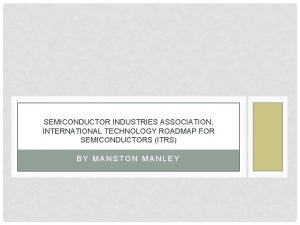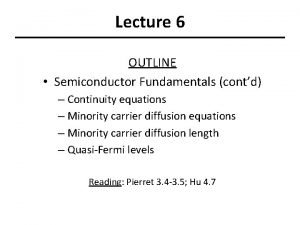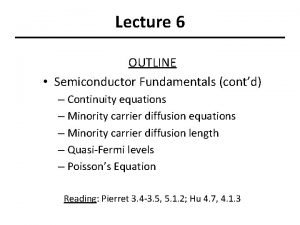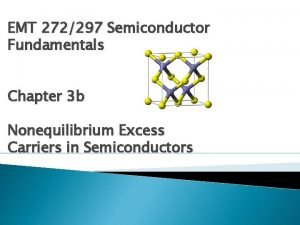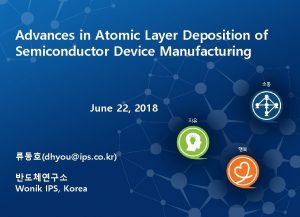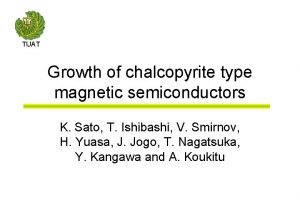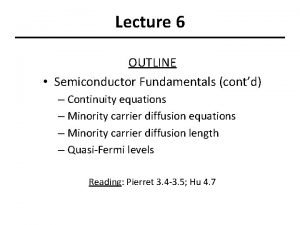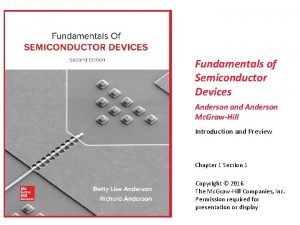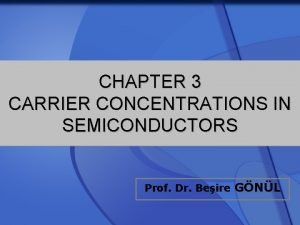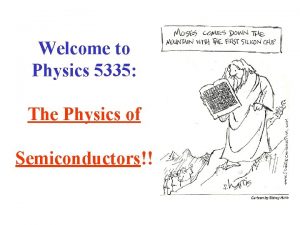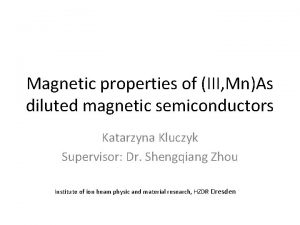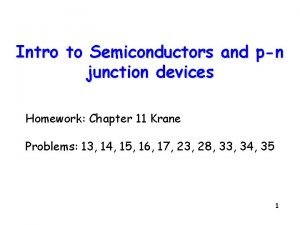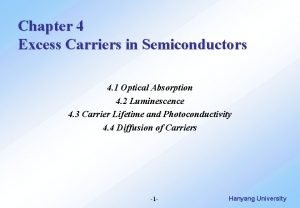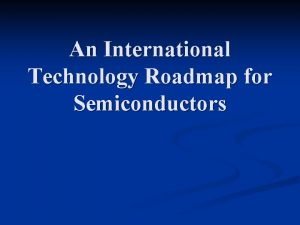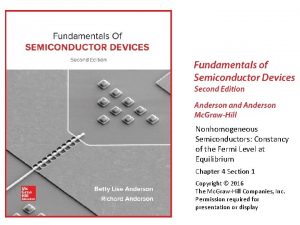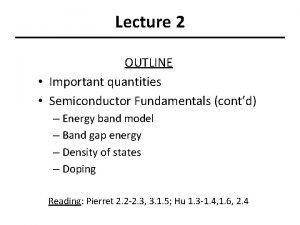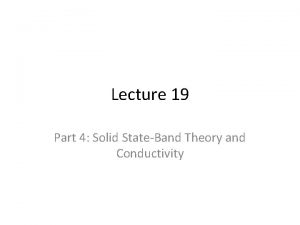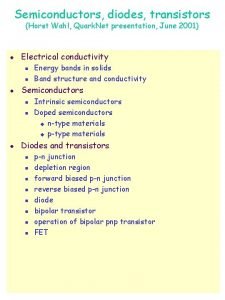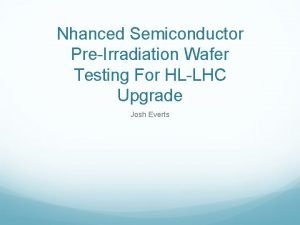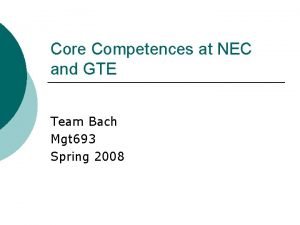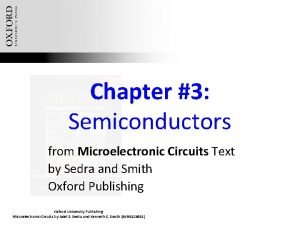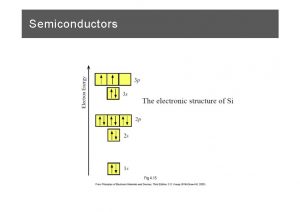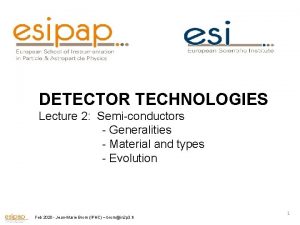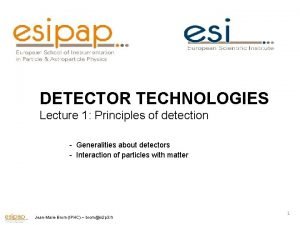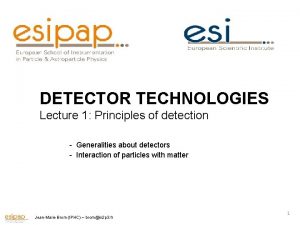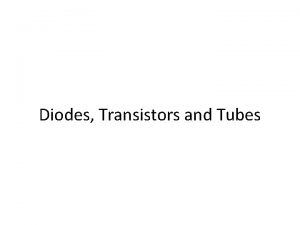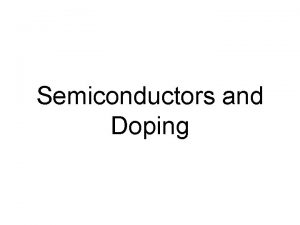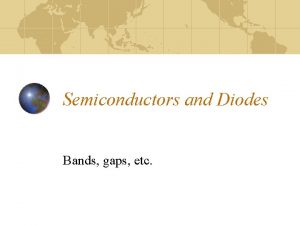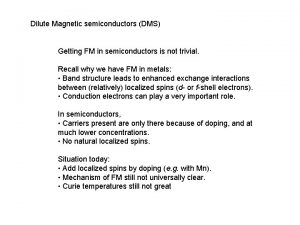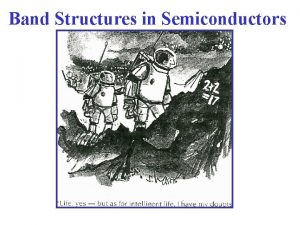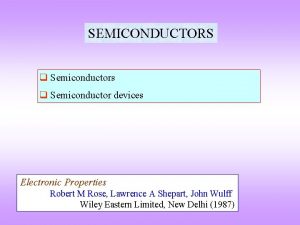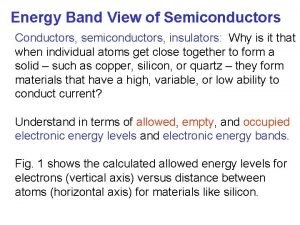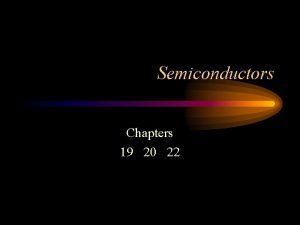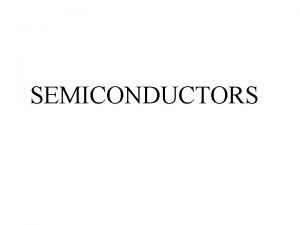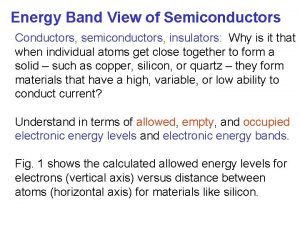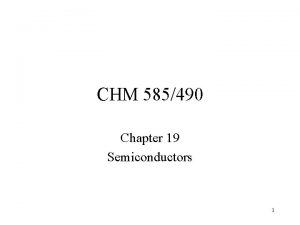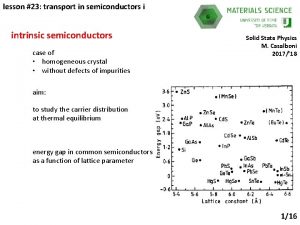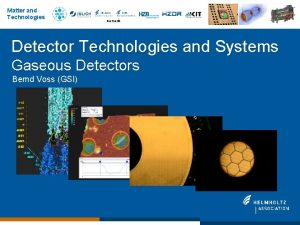DETECTOR TECHNOLOGIES Lecture 3 Semiconductors Generalities Material and













































- Slides: 45

DETECTOR TECHNOLOGIES Lecture 3: Semi-conductors - Generalities - Material and types - Evolution Jean-Marie Brom (IPHC) – brom@in 2 p 3. fr 1

Semiconductors : generalities Solid-States band structures : Valence band : e– bond atoms together Conduction band : e– can freely jump from an atom to another At T ≠ 0 K Electrons may acquire enough energy to pass the band gap… Thermal condution Jean-Marie Brom (IPHC) – brom@in 2 p 3. fr 2

Semiconductors : generalities Not the same ! (Thermal excitation + phonons) Jean-Marie Brom (IPHC) – brom@in 2 p 3. fr 3

Semiconductors : generalities Energy loss by a charged particle : Bethe-Bloch Standard : Energy loss : electrons – holes pairs created (NOT electrons – ions…) If Field (even natural) electrons migration Electrical pulse Information Too simple ! Jean-Marie Brom (IPHC) – brom@in 2 p 3. fr 4

Semiconductors : generalities One MIP in Silicon at 300°K Energy loss : d. E / dx ≈ 388 Ev/µm Ionisation Energy : 3. 62 e. V e – holes pairs created : 107/µm For 300 µm : 3. 2 10 4 pairs created Free charge carriers in the same volume : ≈ 4. 5 10 9 Signal is lost ! Solution : Depletion of the detector - Doping - Blocking contacts Depletion : removing the maximum possible thermally excitable electrons Jean-Marie Brom (IPHC) – brom@in 2 p 3. fr 5

Semiconductors : generalities : the Fano factor Si 0. 115 Ge 0. 13 Ga. As 0. 10 Diamond 0. 08 Fano factor related to energy resolution : A Fano factor < 1 means that the energy resolution would be better than Theoretically expected… Jean-Marie Brom (IPHC) – brom@in 2 p 3. fr 6

Semiconductors : generalities : p and n types dopants : Boron, Arsenic, Phosphorous, Gallium Jean-Marie Brom (IPHC) – brom@in 2 p 3. fr 7

Semiconductors : generalities : p and n types Typically : doping level for a Silicon Detector : 10 12 atoms / cm 3 Doping us usually done by ion implantation. Jean-Marie Brom (IPHC) – brom@in 2 p 3. fr 8

Semiconductors : generalities : junction detectors A p-n junction is formed when a single crystal of semiconductor is doped with acceptors on one side and donors on the other Jean-Marie Brom (IPHC) – brom@in 2 p 3. fr 9

Semiconductors : generalities : junction detectors Jean-Marie Brom (IPHC) – brom@in 2 p 3. fr 10

Semiconductors : generalities : reverse biasing scheme The p – n zones will be used for contact and to block (Blocking Contacts) the undesired noise Jean-Marie Brom (IPHC) – brom@in 2 p 3. fr 11

Semiconductors : generalities : building DC Coupling Silicon detector Jean-Marie Brom (IPHC) – brom@in 2 p 3. fr 12

Semiconductors : generalities : building AC Coupling Silicon detector Jean-Marie Brom (IPHC) – brom@in 2 p 3. fr 13

Semiconductors : generalities : building AC coupled Si detectors create 2 electrical circuits : - Read-out circuit to the amplifier (AC current) - Biasing circuit (DC current) Jean-Marie Brom (IPHC) – brom@in 2 p 3. fr 14

Semiconductors : generalities : building AC Coupling Silicon detector : bias voltage system Jean-Marie Brom (IPHC) – brom@in 2 p 3. fr 15

Semiconductors : Si detectors designs Most commonly scheme AC + poly S-bias resistor Jean-Marie Brom (IPHC) – brom@in 2 p 3. fr 16

Semiconductors : Si detectors designs CMS design Jean-Marie Brom (IPHC) – brom@in 2 p 3. fr ATLAS design 17

Semiconductors : Si detectors designs Jean-Marie Brom (IPHC) – brom@in 2 p 3. fr 18

Semiconductors : Radiation Damage Two types of radiation damage : Bulk (Crystal) damage due to Non Ionizing Energy Loss (NIEL) - displacement damage, built up of crystal defects – Change of effective doping concentration (higher depletion voltage, under- depletion) Increase of leakage current (increase of noise, thermal runaway) Increase of charge carrier trapping (loss of charge) Surface damage due to Ionizing Energy Loss (IEL) - accumulation of positive in the oxide (Si. O 2) and the Si/Si. O 2 interface – affects: interstrip capacitance (noise factor), breakdown behavior, … Impact on detector performance (depending on detector type and geometry and readout electronics!) Signal/noise ratio is the quantity to watch Sensors can fail from radiation damage ! Jean-Marie Brom (IPHC) – brom@in 2 p 3. fr 19

Semiconductors : Effect of radiations Loss of collected charges (new 300 µm Silicon ≈ 24 000 e- for 1 MIP) Trapping is characterized by an effective trapping time eff for electrons and holes: where Jean-Marie Brom (IPHC) – brom@in 2 p 3. fr 20

Semiconductors : Effect of radiations Increase of Leakage current Jean-Marie Brom (IPHC) – brom@in 2 p 3. fr 21

Semiconductors : Effect of radiations Change in depletion voltage and type inversion before inversion p+ n+ after inversion Jean-Marie Brom (IPHC) – brom@in 2 p 3. fr 22

Semiconductors : 2 -dimensional detectors Double Sided Silicon Detectors (DSSD) Not much in use… Jean-Marie Brom (IPHC) – brom@in 2 p 3. fr 23

Semiconductors : 2 -dimensional detectors Stereo Modules Jean-Marie Brom (IPHC) – brom@in 2 p 3. fr 24

Semiconductors : Performance Jean-Marie Brom (IPHC) – brom@in 2 p 3. fr 25

Semiconductors : Pixels Detectors Pixel sizes : ATLAS : 50 µm x 400 µm CMS : 100 µm x 150 µm ALICE : 50 µm x 425 µm Jean-Marie Brom (IPHC) – brom@in 2 p 3. fr 26

Semiconductors : Pixels Detectors CONNECTION BY BUMP BONDING Jean-Marie Brom (IPHC) – brom@in 2 p 3. fr 27

Semiconductors : Pixels Detectors Pitch : 50 µm (wire bonding typically 200µm) Jean-Marie Brom (IPHC) – brom@in 2 p 3. fr 28

Semiconductors : Silicon history CDF NA 11 DELPHI CMS ≈ 215 m 2 ATLAS ≈ 61 m 2 LHCb ≈ 12. 5 m 2 CDF ≈ 3. 5 m 2 ALICE ≈ 1. 5 m 2 Jean-Marie Brom (IPHC) – brom@in 2 p 3. fr 29

Semiconductors : CMS Silicon Detector Jean-Marie Brom (IPHC) – brom@in 2 p 3. fr 30

Semiconductors : CMS Silicon Detector Jean-Marie Brom (IPHC) – brom@in 2 p 3. fr 31

Semiconductors : ATLAS Silicon Detector Jean-Marie Brom (IPHC) – brom@in 2 p 3. fr 32

Semiconductors : ATLAS Silicon Detector Jean-Marie Brom (IPHC) – brom@in 2 p 3. fr 33

Semiconductors : CMS and ATLAS Silicon Detector Jean-Marie Brom (IPHC) – brom@in 2 p 3. fr 34

Semiconductors : Challenges and Evolutions Main Challenge : The LHC at High Luminosity (2024 ? ) More tracks : Occupancy increases - Less resolution More Flux : Radiation (bulk) damage Jean-Marie Brom (IPHC) – brom@in 2 p 3. fr 35

Semiconductors : Challenges and Evolutions Reduce the Occupancy : Increase the granularity Mini-strips sensors (reduce lenght from 10 cm to 5 cm) - Increases the number of channels - Increases the cost - Increases the power to be dissipated Reduce the matérial : Thin Si sensors - Reduce the Charges Collected Reduce the number of layers - Reduce the overall Tracker efficiency 300 µm Jean-Marie Brom (IPHC) – brom@in 2 p 3. fr 150 µm 36

Semiconductors : Challenges and Evolutions Change the material : Oxygenated Silicon HE detectrors : FZ (Float Zone) Crystal - High resistivity > 3 -4 kΩcm - O 2 contens < 50 10 16 New Materials : DOFZ : O 2 doped FZ Silicon (Oxydation of wafer at high temperature) MCZ (Magnetic Czochralki) - Less resistivity ≈ 1. 5 kΩcm - O 2 contens > 5 10 17 EPITAXIAL growth : Chemical Vapor Deposition on CZ substrate EPI layer CZ substrate Oxygen concentration in DOFZ Jean-Marie Brom (IPHC) – brom@in 2 p 3. fr Oxygen concentration in Epitaxial 37

Semiconductors : Challenges and Evolutions 24 Ge. V/c proton irradiation Standard FZ silicon • type inversion at ~ 2 1013 p/cm 2 • strong Neff increase at high fluence Oxygenated FZ (DOFZ) • type inversion at ~ 2 1013 p/cm 2 • reduced Neff increase at high fluence CZ silicon and MCZ silicon § no type inversion in the overall fluence range (verified by TCT measurements) (verified for CZ silicon by TCT measurements, preliminary result for MCZ silicon) donor generation overcompensates acceptor generation in high fluence range Common to all materials (after hadron irradiation): § reverse current increase § increase of trapping (electrons and holes) within ~ 20% Jean-Marie Brom (IPHC) – brom@in 2 p 3. fr 38

Semiconductors : Challenges and Evolutions MAPS (Monolithic Active Sensor) or CMOS (Complementary Metal Oxide Semiconductor) Jean-Marie Brom (IPHC) – brom@in 2 p 3. fr 39

Semiconductors : Challenges and Evolutions 3 D Silicon Detectors Manufacturing challenge Electrodes : dead zones Efficiency vs fluence Jean-Marie Brom (IPHC) – brom@in 2 p 3. fr 40

Semiconductors : Challenges and Evolutions Diamond detectors CVD Diamond Si Z 6 14 Energy Gap 5, 5 e. V 1, 21 to 1, 1 e. V Resistivity 1013 – 1016 Ωcm 105 – 106 Ωcm Breakdown 107 V/cm 3. 105 V/cm Mobility (electrons) 2000 cm 2/V/s 1350 cm 2/V/s Mobility (holes) 1600 cm 2/V/s 480 cm 2/V/s Displacement Energy (e-) 43 e. V/atom 13 à 20 e. V/atom Pairs Creation 13 e. V 3. 6 e. V Charge Collection Distance 250 m 100 m ? Mean signal (MIP) 3600 e- / m 8900 e- / m Dielectric Constant 5. 5 10 à 12 Thermal Conductivity (W/m·K) 1600 2000 150 Jean-Marie Brom (IPHC) – brom@in 2 p 3. fr Diamond is better than Silicon Does not need any doping Better radiation hardness Better thermal conductivity Better speed Light insensitive Multi-metalization possible (test and physics) But : 3 times less signal for MIPs Difficult to manufacture Expensive Diamond is not understood (at the moment) 2 forms : Polycristalline Wafer 6 inches Monocrystalline max : 4 x 4 mm 2 41

Semiconductors : Challenges and Evolutions Problem : Charge Collection Distance At LHC, need of 9000 – 1000 e- for an MIP : need a CCD ≥ 270 – 300 µm Jean-Marie Brom (IPHC) – brom@in 2 p 3. fr 42

Semiconductors : Challenges and Evolutions Still plenty of questions about diamond: Some diamond are Schottky diodes (start to be conductive) 2, 50 E-09 3, 00 E-09 AT-2011 -19 -2 2, 50 E-09 2, 00 E-09 ? 1, 50 E-09 1, 00 E-09 0, 00 E+00 -500 -400 -300 -200 -100 200 300 400 5, 00 E-10 I(V) curve : leakage current (2 faces) from - 500 V to + 500 V Jean-Marie Brom (IPHC) – brom@in 2 p 3. fr 2, 00 E-09 1, 50 E-09 1, 00 E-09 5, 00 E-10 0, 00 E+00 -500 -400 -300 -200 -100 200 300 400 500 On one side, diamond starts to be conductive at + 100 V 43

Semiconductors : Challenges and Evolutions Still plenty of questions about diamond: Influence of surface finishing Number of electrons measured on the same diamond with 2 different metalization ? Metal ( Au) by Evap : 14 000 e- Metal (Al) by Plasma : 16 000 e- Commercial : A 4 -years program is under way to prove the feasibility of diamond detectors for SLHC With LPSC –Grenoble and IPHC –Strasbourg (and other) Jean-Marie Brom (IPHC) – brom@in 2 p 3. fr 44

Jean-Marie Brom (IPHC) – brom@in 2 p 3. fr 45
 Hpdcms
Hpdcms 01:640:244 lecture notes - lecture 15: plat, idah, farad
01:640:244 lecture notes - lecture 15: plat, idah, farad Direct and indirect band gap semiconductors
Direct and indirect band gap semiconductors Optical loss and gain in semiconductors
Optical loss and gain in semiconductors Elemental and compound semiconductors
Elemental and compound semiconductors Elemental and compound semiconductors
Elemental and compound semiconductors Propaganda card stacking examples
Propaganda card stacking examples Geometric symbol
Geometric symbol Culture includes
Culture includes Whats cultural lag
Whats cultural lag Examples of non material culture
Examples of non material culture Useful but harmful materials
Useful but harmful materials Introduction to semiconductors
Introduction to semiconductors Itrs semiconductor
Itrs semiconductor The international technology roadmap for semiconductors
The international technology roadmap for semiconductors Continuity equation
Continuity equation Continuity equation semiconductor
Continuity equation semiconductor Equation of continuity in semiconductors
Equation of continuity in semiconductors Semiconductor
Semiconductor Konduktor isolator dan semikonduktor
Konduktor isolator dan semikonduktor Equipement used for making semiconductors
Equipement used for making semiconductors Continuity equation
Continuity equation Fundamentals of semiconductor devices anderson solution
Fundamentals of semiconductor devices anderson solution Ni semiconductor
Ni semiconductor The physics of semiconductors
The physics of semiconductors Magnetic semiconductors
Magnetic semiconductors Semiconductor junction devices
Semiconductor junction devices Quasi fermi level
Quasi fermi level Semiconductor roadmap
Semiconductor roadmap Bank of america semiconductors
Bank of america semiconductors Classification of semiconductor
Classification of semiconductor Semiconductor
Semiconductor Semiconductors band gap
Semiconductors band gap Semiconductors band gap
Semiconductors band gap Semiconductors
Semiconductors Nhanced semiconductor
Nhanced semiconductor Nec semiconductors livingston
Nec semiconductors livingston Semiconductors
Semiconductors Glittering generality
Glittering generality Glittering generalities
Glittering generalities Rewards propaganda technique
Rewards propaganda technique Examples of name-calling
Examples of name-calling Propaganda in animal farm
Propaganda in animal farm Bandwagon and other persuasive techniques
Bandwagon and other persuasive techniques Bandwagon food ads
Bandwagon food ads Bandwagon meaning propaganda
Bandwagon meaning propaganda
